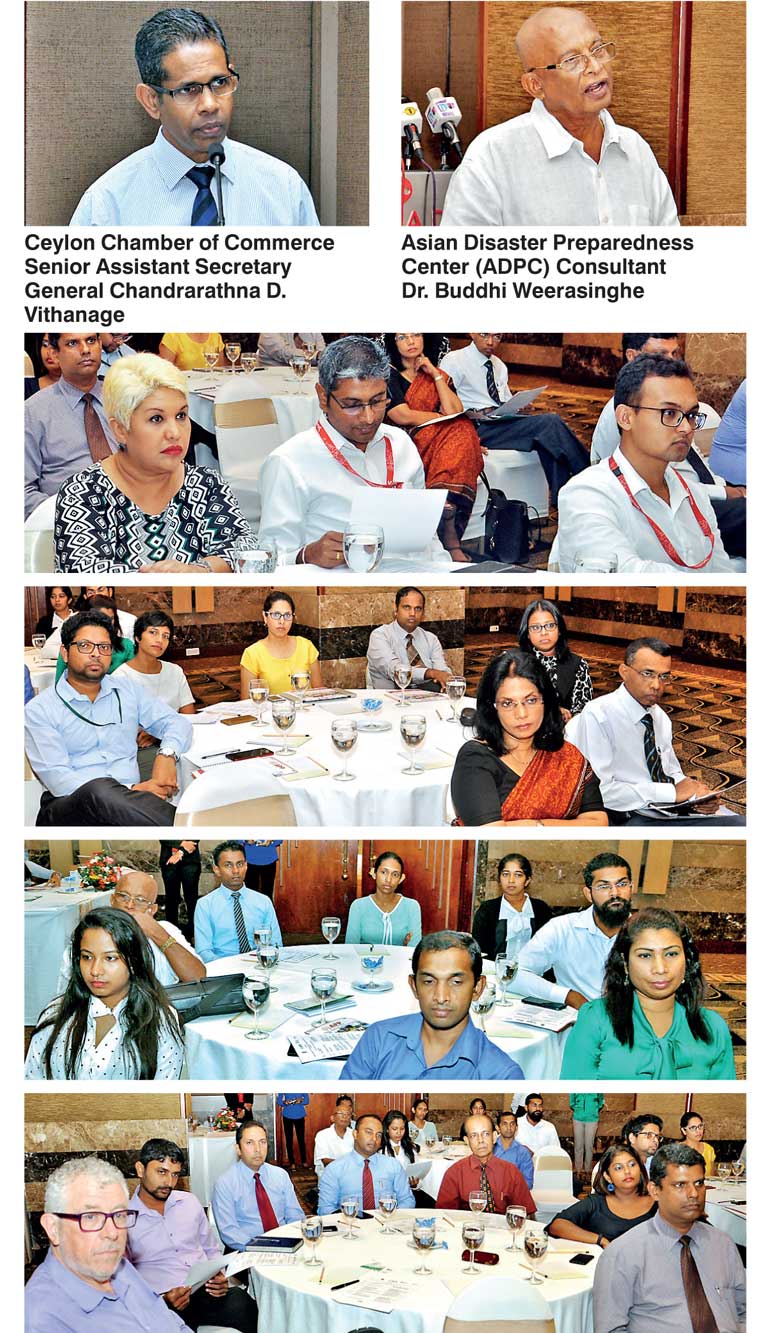Friday Dec 26, 2025
Friday Dec 26, 2025
Thursday, 16 November 2017 00:47 - - {{hitsCtrl.values.hits}}
 By Shannon Jayawardena
By Shannon Jayawardena
Sri Lanka’s capacity to face natural disasters is a low 18% due to weak contingency planning and disaster mitigation, which is hampered by scarce research and inconsistent database management, experts said yesterday, calling on the private sector to become a driver of disaster preparedness.
At present only 18% capacity building is being done because contingency planning and disaster mitigation is very weak. Experts pointed out that in Sri Lanka research is scarce, database management is tremendously low, risk awareness is adequate but not effectively assessed and the country consists of just one warehouse in case of cyclones.
In an effort to increase Sri Lanka’s disaster preparedness the Ceylon Chamber of Commerce (CCC) along with other organisations formed the Sri Lanka Preparedness Partnership (SLPP), which aims to join several private sector organisations to raise awareness and gain better focus on the problem.
The private sector plays a key role in society and can be a driving source when it comes to taking precautions on risk management. Organisations can start from the grass root level by creating emergency response for their institutions, enhancing the supply chain by stockpiling and finally by participating in workshops on hazard mapping to create better awareness.
The Ceylon Chamber of Commerce Senior Assistant Secretary General Chandrarathna D. Vithanage said “Sri Lanka has a very strong private sector and they have actively participated in disaster recovery and construction activities. I can very well remember I was co-ordinating the tsunami relief activities from the chamber and at that time over 170 schools destroyed and 168 of these schools were rebuilt by the private sector. Large number of housing schemes and so many other reconstruction activities were undertaken by the private sector.”
Partner organisation Asian Disaster Preparedness Centre (ADPC) together with the CCC has created the SLPP to act as an advisory service for disaster and climate risk management and focus on resilient recovery and preparedness for response.
The ADPC is working towards strengthening the capacity of Government and local humanitarian organisations on preparedness for response by enhancing capacities through partnerships, knowledge resources, training and networking opportunities not only in Sri Lanka but Asia as a whole.
Asian Disaster Preparedness Centre Consultant Buddhi Weerasinghe stated: “For the private sector there are three things we need to focus on; one is emergency response for your own institution, second is a stable supply chain and third is the public, your clients, buyers and anyone who can benefit from your organisation.”
“Looking into what the private sector can do for the public and the company risk management strategies there are several ways of looking into disaster management that is avoidance, reduction, sharing and finally acceptance,” he added.
Based on this method companies should avoid basing their operations on regions that are exposed to natural hazards, reduce the likelihood or impacts by selecting suppliers carefully, developing emergency planning actions and upgrading existing safety infrastructure, share risks through contractual agreements with suppliers, buyers and public institutions and accept residual disasters.
Thereby once other strategies have been leveraged and implemented there is a common agreement that ‘zero risk’ can never be achieved and one should always expect the unexpected.
Not only does disaster affect the civil society but affects the country’s economy as well. It leads to direct and indirect losses with wider impacts as companies are macro economically affected with labour and resource shortages.
The floods that occurred in May 2016 affected half a million people leading to 101 deaths and 100 missing people cases filed. However the floods that took place in May this year hit much more critically as the death toll rose to 224 and affected 200,382 people while 13,149 households were destroyed.
Climatic disasters are unexpected but the damage caused can be minimised greatly if the proper actions and precautions are taken. The main issue in Sri Lanka with regards to risk and disaster management is the lack of efficient data. Thereby most of the accounted losses are due to the lack of preparedness.
Like so the Government has being contributing towards the disaster preparedness but the steps taken towards the issue have not been organised in an efficient manner. At present it is only the geological and hydro meteorological information that is being looked into whereby long-term responses should be evaluated with a deeper regard.
For example the earthquake that hit Japan in 2011 led to their GDP to fall by 3.1% and Toyota lost $1.2 billion in product revenue. 2011 Thailand floods led to their GDP to fall by 9% and lost its place as the number one global rice exposer. Sri Lanka has 50% higher disaster loss when compared to these global countries because of the unpreparedness that has to be enhanced greatly.
Pix by Ruwan Walpola